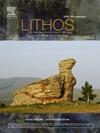Geochemical and isotopic constraints on the petrogenesis and tectonic setting of basalts in the Nagaland Ophiolite Complex, Northeast India
IF 2.9
2区 地球科学
Q2 GEOCHEMISTRY & GEOPHYSICS
引用次数: 0
Abstract
The Nagaland Ophiolite Complex (NOC) is exposed at the eastern margin of the Indo-Burma Range, which represents the suture zone between the Indian and Burmese Plates. The NOC that contains a complete mantle and crustal lithological assemblage can provide important information regarding the tectonic evolution of the Neo-Tethys Ocean. The studied basaltic rocks from the NOC can be classified into two groups according to their geochemical results. The Group I rocks are geochemically comparable with the E-MORB, which have slight LREE enrichment ((La/Yb)N = 1.45–1.96). The Group II rocks share geochemical characteristics with typical N-MORB and exhibit LREE depletion, with (La/Yb)N of 0.47–0.69. All samples showed slightly positive or insignificant anomalies in high-field-strength elements. The Group I and Group II rocks were derived from the partial melting of spinel-facies mantle peridotite, and the degrees of partial melting of the former (approximately 5 %) are lower than those of the latter (approximately 10 %). Both groups of basaltic rocks are characterized by high positive εNd(t) values (+7.0 − +7.6 and + 5.4 − +8.3, respectively). Our study revealed that the Group I rocks were predominantly derived from a MORB-like asthenospheric source that was variably enriched by OIB-type components, whereas the Group II rocks were derived from a depleted asthenospheric mantle source without the contribution of OIB-type components. The heterogeneous asthenospheric mantle sources contributed to the geochemical complexities of the basalts from the NOC. These results, combined with regional geological records, suggest that the basalts from the NOC were mainly generated in a mid-ocean ridge setting during the evolution of the Neo-Tethys Ocean.
印度东北部那加兰蛇绿岩杂岩中玄武岩成因和构造背景的地球化学和同位素约束
那加兰蛇绿岩杂岩(naaland Ophiolite Complex, NOC)发育在印缅山脉东缘,是印缅板块的缝合带。NOC包含完整的地幔和地壳岩性组合,可以提供有关新特提斯洋构造演化的重要信息。根据地球化学结果,研究区玄武岩可分为两类。I组岩石的地球化学特征与E-MORB组相当,均有轻微的LREE富集((La/Yb)N = 1.45 ~ 1.96)。II组岩石具有典型的N- morb地球化学特征,表现为LREE亏缺,(La/Yb)N为0.47 ~ 0.69。所有样品在高场强元素中均表现出轻微阳性或不显著的异常。第一组和第二组岩石为尖晶石相地幔橄榄岩的部分熔融产物,前者部分熔融程度(约5%)低于后者(约10%)。两组玄武岩均具有较高的正εNd(t)值(分别为+7.0 ~ +7.6和+ 5.4 ~ +8.3)。研究表明,ⅰ组岩石主要来源于类似morb的软流圈源,并被obb型组分富集,而ⅱ组岩石则来源于枯竭的软流圈地幔源,没有obb型组分的贡献。软流圈地幔源的非均匀性增加了华北地区玄武岩地球化学的复杂性。这些结果结合区域地质记录表明,NOC玄武岩主要产生于新特提斯洋演化过程中的洋中脊环境。
本文章由计算机程序翻译,如有差异,请以英文原文为准。
求助全文
约1分钟内获得全文
求助全文
来源期刊

Lithos
地学-地球化学与地球物理
CiteScore
6.80
自引率
11.40%
发文量
286
审稿时长
3.5 months
期刊介绍:
Lithos publishes original research papers on the petrology, geochemistry and petrogenesis of igneous and metamorphic rocks. Papers on mineralogy/mineral physics related to petrology and petrogenetic problems are also welcomed.
 求助内容:
求助内容: 应助结果提醒方式:
应助结果提醒方式:


